Miniaturised Infrared Spectrophotometer for Low Power Consumption Multi-Gas Sensing
Abstract
:1. Introduction
2. Materials and Methods
2.1. Optical Design and Construction
2.2. MEMS Micro-Hotplate as the Infrared Source
2.3. Infrared Detector
2.4. Optical Filter
2.4.1. Linear Variable Filters
2.4.2. Fixed-Line Optical Pass Band Filter
2.5. Electronics
2.6. Modelling
3. Results
3.1. Absorption Modelling Calculation
3.2. Power Consumption
3.3. Gas Concentration Tests
- (a)
- Methane was detectable at 100 ppm, 500 ppm and 25,000 ppm (below lower explosive limit)—but longer sampling times and faster sampling techniques are required as these improve detection by compensating for the noise fluctuations in the system. Figure 15 shows how the PbSe detector output indicated 2.5% Methane detection.In addition to methane, the following performance for CO2 and CO observed:
- (b)
- CO2: Very good detection at 50 ppm, 100 ppm and 170 ppm.
- (c)
- CO: Tested at 50 ppm and tests did not show evident detection due to lowered S/N levels in the system. CO detection is more difficult due to the centre wavelength at 4.65 µm lying on the falling edge of the lead selenide detector D*—lambda curve.
3.4. Temperature Sensitivity
3.5. Varying Pathlengths and Optical Throughputs
3.6. Measurement Accuracy for Various Gases
4. Conclusions and Future Work
Author Contributions
Funding
Acknowledgments
Conflicts of Interest
References
- Krier, A. Mid-Infrared Semiconductor Optoelectronics; Krier, A., Ed.; Springer: New York, NY, USA, 2006. [Google Scholar]
- Wong, J.Y. NDIR Gas Sensor. U.S. Patent 5,834,777, 1995. [Google Scholar]
- Stuart, B.H. Infrared Spectroscopy: Fundamentals and Applications (Analytical Techniques in the Sciences (AnTs)); John Wiley and Sons: Hoboken, NJ, USA, 2004; ISBN 978-0-470-85428-6. [Google Scholar]
- Miller, J.L. Principles of Infrared Technology: A Practical Guide to the State of the Art, 1st ed.; Springer: New York, NY, USA, 2001; ISBN 978-0-412-09861-1. [Google Scholar]
- Popa, D.; Udrea, F. Towards Integrated Mid-Infrared Gas Sensors. Sensors 2019, 19, 2076. [Google Scholar] [CrossRef] [PubMed] [Green Version]
- Du, Y.; Peng, Z.; Ding, Y. High-accuracy sinewave-scanned direct absorption spectroscopy. Opt. Express 2018, 26, 29550. [Google Scholar] [CrossRef] [PubMed]
- Liu, K.; Mei, J.; Zhang, W.; Chen, W.; Gao, X. Multi-resonator photoacoustic spectroscopy. Sens. Actuators B Chem. 2017, 251, 632–636. [Google Scholar] [CrossRef]
- Ma, Y. Review of Recent Advances in QEPAS-Based Trace Gas Sensing. Appl. Sci. 2018, 8, 1822. [Google Scholar] [CrossRef] [Green Version]
- Vergara, A.; Vembu, S.; Ayhan, T.; Ryan, M.A.; Homer, M.L.; Huerta, R. Chemical gas sensor drift compensation using classifier ensembles. Sens. Actuators B Chem. 2012, B166–B167, 320–329. [Google Scholar] [CrossRef]
- Hauptmann, P. Sensors: Principles & Application, 201st ed.; Prentice Hall Inc.: Englewood Cliffs, NJ, USA, 1993. [Google Scholar]
- Korotcenkov, G. Metal oxides for solid-state gas sensors: What determines our choice? Mater. Sci. Eng. B 2007, 139, 1–23. [Google Scholar] [CrossRef]
- Williams, D.E. Conduction and gas response of semiconductor gas sensors Solid State Gas Sensors. In Solid State Gas Sensors, (Adam Hilger Series on Sensors); Tofield, B.C., Ed.; CRC Press: Bristol, UK, 1987. [Google Scholar]
- Bakker, E.; Telting-Diaz, M. Electrochemical Sensors. Anal. Chem. 2002, 74, 2781–2800. [Google Scholar] [CrossRef] [PubMed]
- Esler, M.B.; Griffith, D.W.T.; Wilson, S.R.; Steele, L.P. Precision Trace Gas Analysis by FT-IR Spectroscopy. 1. Simultaneous Analysis of CO2, CH4, N20, and CO in Air. Anal. Chem. 2000, 72, 206–215. [Google Scholar] [CrossRef] [PubMed]
- Radwan, L. Infrared CO2 analysis in expired air as a test of the pulmonary function. I. Evaluation of the capnographic curve. Pol. Med. J. 1976, 6, 403–411. [Google Scholar] [PubMed]
- Apte, M.G. A Review of Demand Controlled Ventilation; Universidade de Porto: Porto, Portugal, 2006. [Google Scholar]
- Gravenstein, J.S.; Jaffe, M.B.; Gravenstein, N.; Paulus, D.A. Capnography, 2nd ed.; Cambridge University Press: Cambridge, UK, 2011; ISBN 9780511933837. [Google Scholar]
- Gupta, S.; Khare, M.; Goyal, R. Sick building syndrome—A case study in a multistory centrally air-conditioned building in the Delhi City. Build. Environ. 2007, 42, 2797–2809. [Google Scholar] [CrossRef]
- Jennings, P.R.; Fahringer, D.; Collins, T. Sick building syndrome. Indoor air quality and your patients’ health. JAAPA 2000, 39, 34–36. [Google Scholar]
- Information Administration—US Department of Energy, D.I.-0384. Energy Rev. 2009; 2010. Available online: http://www.eia.gov/aer (accessed on 9 July 2020).
- Van Gastelen, S.; Dijkstra, J. Prediction of methane emission from lactating dairy cows using milk fatty acids and mid-infrared spectroscopy. J. Sci. Food Agric. 2016, 96, 3963–3968. [Google Scholar] [CrossRef] [PubMed]
- Gibson, D.; MacGregor, C. A Novel Solid State Non-Dispersive Infrared CO2 Gas Sensor Compatible with Wireless and Portable Deployment. Sensors 2013, 13, 7079–7103. [Google Scholar] [CrossRef] [PubMed] [Green Version]
- Liu, H.; Chu, R.; Tang, Z. Metal Oxide Gas Sensor Drift Compensation Using a Two-Dimensional Classifier Ensemble. Sensors 2015, 15, 10180–10193. [Google Scholar] [CrossRef] [PubMed] [Green Version]
- Gibson, D.; Waddell, E. Miniaturised Infrared Spectrophotometer. Patent Application Number GB1702480.3, 15 February 2018. [Google Scholar]
- Welfor, W.T.; Winston, R. High Collection Nonimaging Optics; Academic Press: Cambridge, MA, USA, 1989. [Google Scholar]
- Wang, C.H.; Crowder, J.G.; Smith, S.D.; Bramley, P.; Vass, A. Comparison of IR LED gas sensors with thermal source products. IEE Proc. Optoelectron. 1997, 144, 266–270. [Google Scholar] [CrossRef]
- Elmi, I.; Zampolli, S.; Cozzani, E.; Passini, M.; Cardinali, G.C.; Severi, M. Development of Ultra Low Power Consumption Hotplates for Gas Sensing Applications. In Proceedings of the 2006 5th IEEE Conference on Sensors, Daegu, Korea, 22 October 2006; pp. 243–246. [Google Scholar]
- Cozzani, E.; Roncaglia, A.; Zampolli, S.; Elmi, I.; Mancarella, F.; Tamarri, F.; Cardinali, G.C. Material Properties Measurement and Numerical Simulation for Characterization of Ultra-Low-Power Consumption Hotplates. In Proceedings of the TRANSDUCERS 2007—2007 International Solid-State Sensors, Actuators and Microsystems Conference, Lyon, France, 10 June 2007; pp. 1661–1664. [Google Scholar]
- Kharbanda, D.; Khanna, P.K.; Shekhar, C.; Mohan, A. Design, simulation and modelling of LTCC based micro hotplate for gas sensor applications. In Proceedings of the 2012 1st International Symposium on Physics and Technology of Sensors (ISPTS-1), Maharashtra, India, 8 March 2012; pp. 257–260. [Google Scholar]
- Moss, T.S. Lead Salt Photoconductors. IRE 1955. [Google Scholar] [CrossRef]
- Downs, C.; Vandervelde, T. Progress in Infrared Photodetectors Since 2000. Sensors 2013, 13, 5054–5098. [Google Scholar] [CrossRef] [PubMed]
- Song, S.; Gibson, D.; Hutson, D. Apparatus and Methods for Depositing Variable Interference Filters. Patent Number WO 2018/150173, 23 August 2018. [Google Scholar]
- Li, C.; Song, S.; Gibson, D.; Child, D.; Chu, H.; Waddell, E. Modeling and validation of uniform large-area optical coating deposition on a rotating drum using microwave plasma reactive sputtering. Appl. Opt. 2017, 56, C65–C70. [Google Scholar] [CrossRef] [PubMed]
- Song, S.; Li, C.; Chu, H.O.; Gibson, D. Reactive dynamics analysis of critical Nb_2O_5 sputtering rate for drum-based metal-like deposition. Appl. Opt. 2017, 56, C206. [Google Scholar] [CrossRef] [PubMed]
- HITRAN (High-Resolution Transmission Molecular Absorption Database). Available online: http://www.cfa.harvard.edu/hitran/ (accessed on 7 May 2020).
- Wang, P.; Fu, X.; Gibson, D.; Fleming, L.; Ahmadzadeh, S.; Li, C.; Muhiyudin, M.; Song, S.; Hutson, D.; Moodie, D.; et al. Optimised Performance of Non-Dispersive Infrared Gas Sensors Using Multilayer Thin Film Bandpass Filters. Coatings 2018, 8, 472. [Google Scholar] [CrossRef] [Green Version]
- Northumbria Optical Coatings Ltd. Available online: https://www.noc-ltd.com/products/narrow-bandpass (accessed on 22 June 2020).
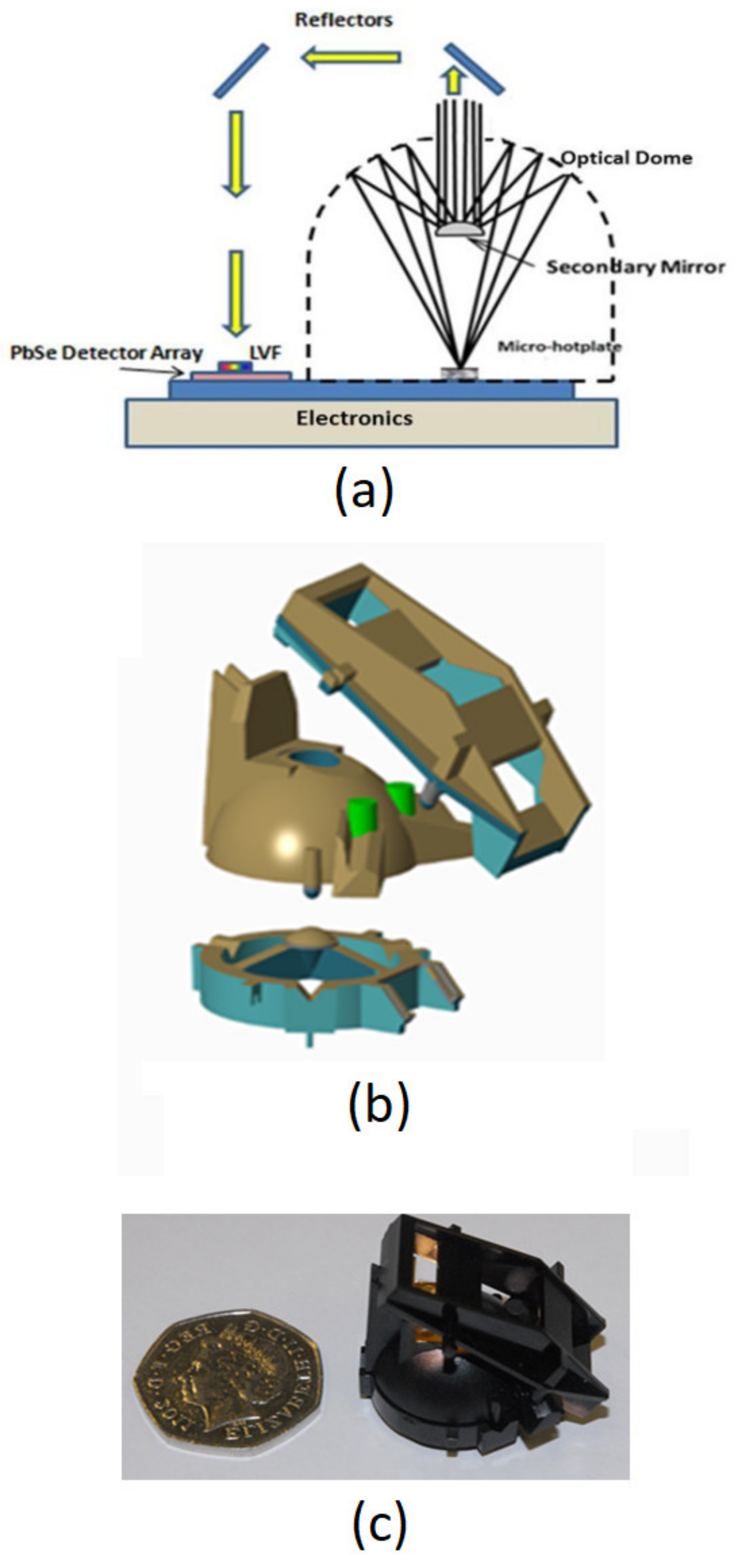
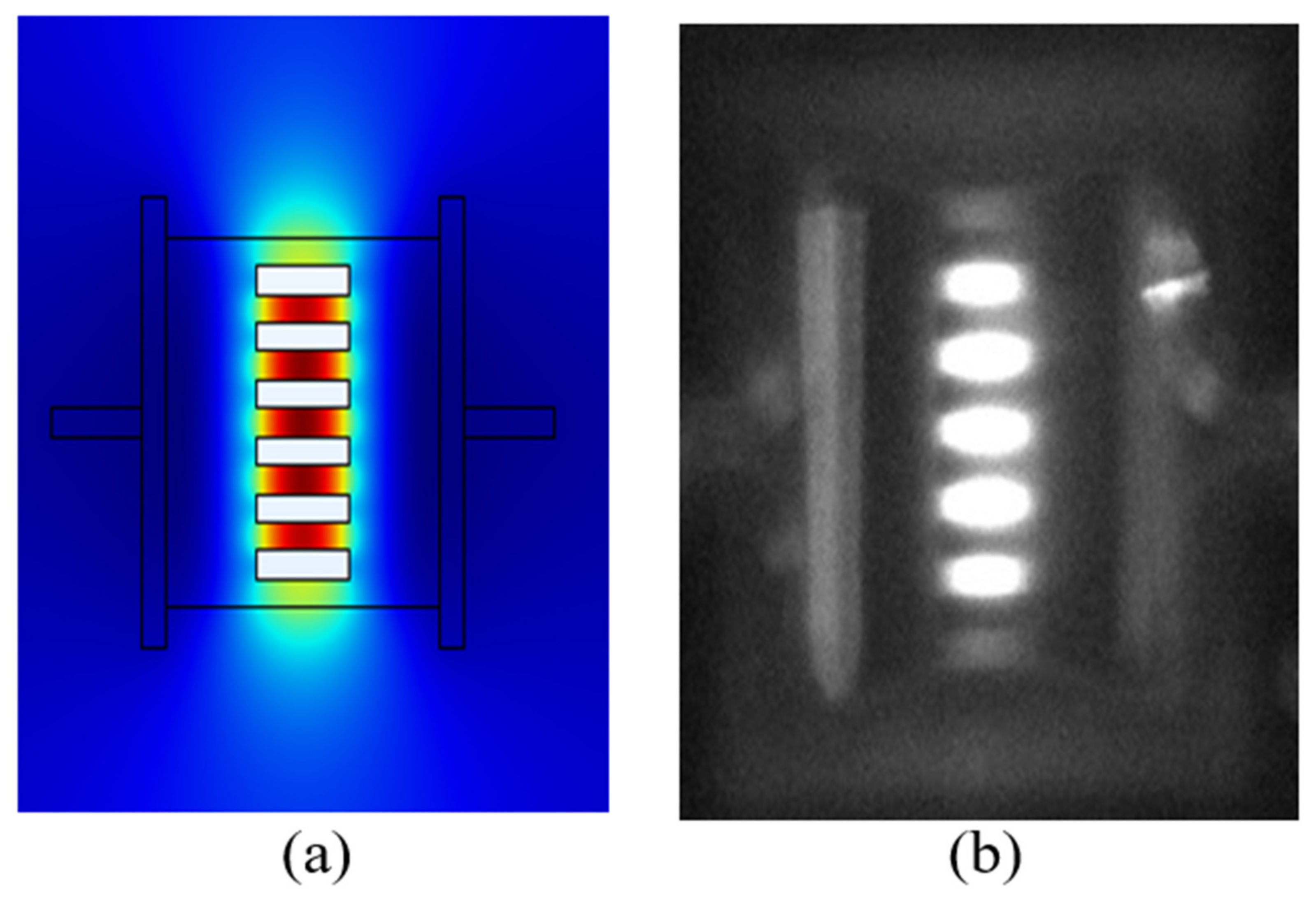
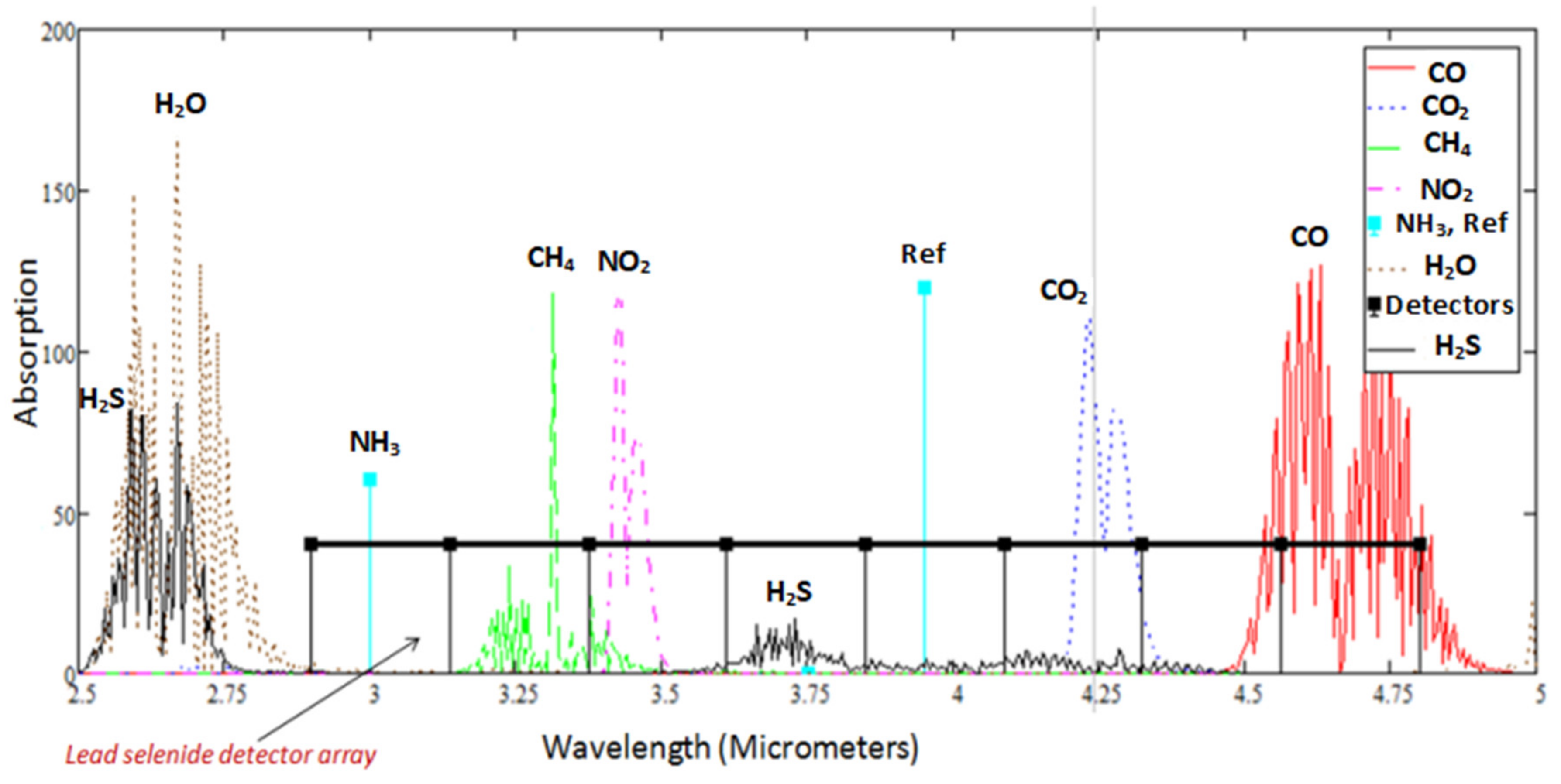
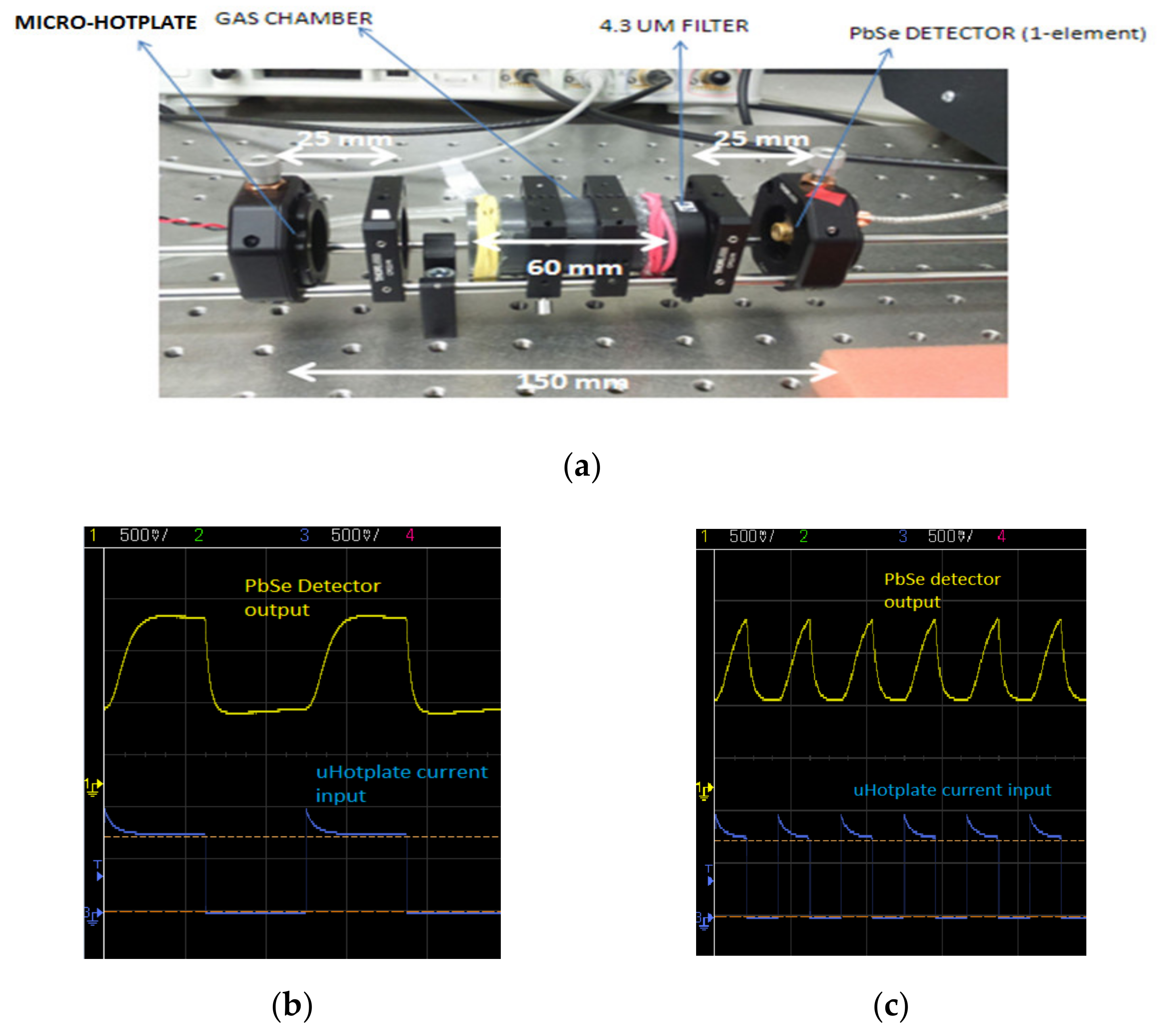

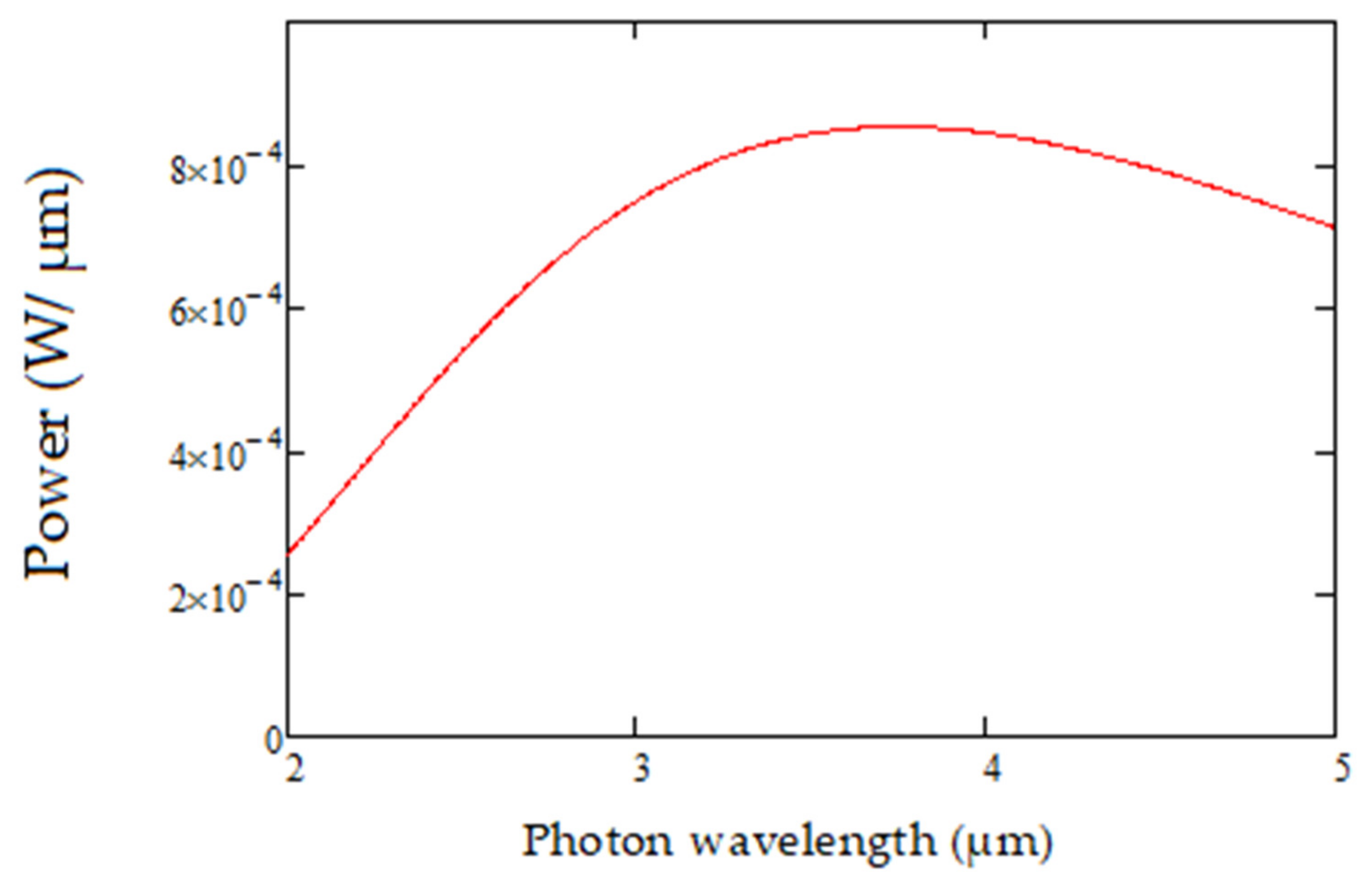

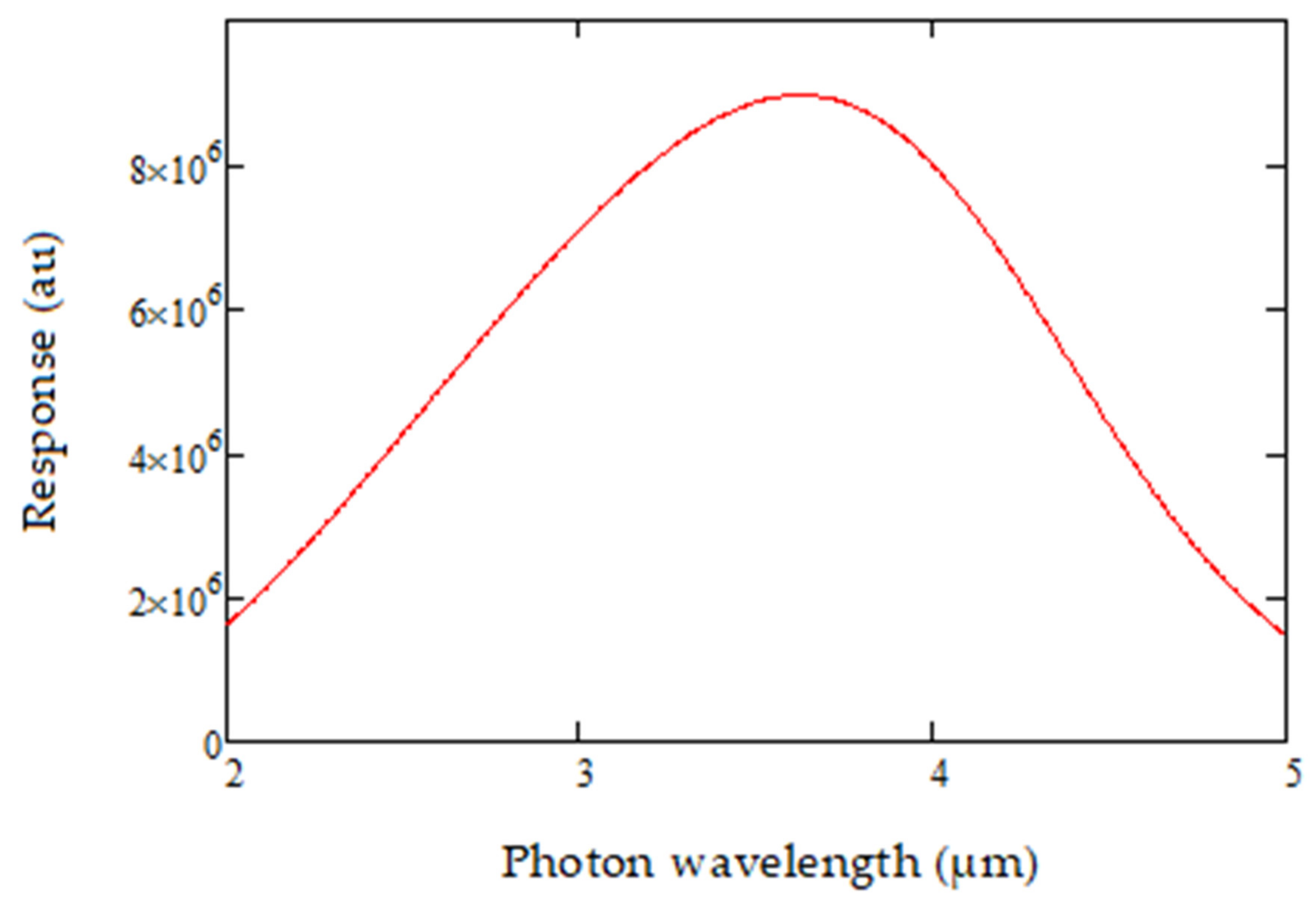

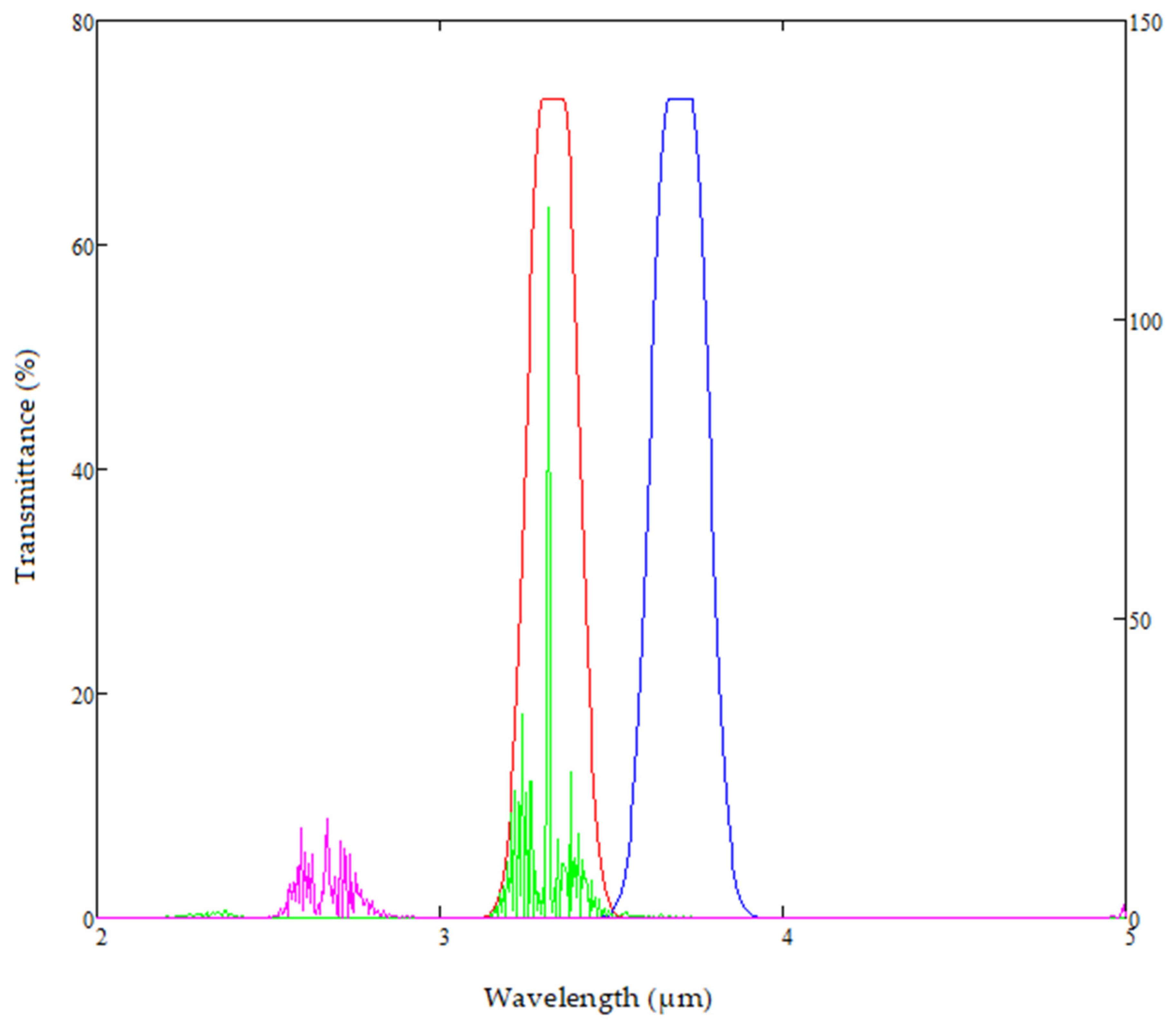

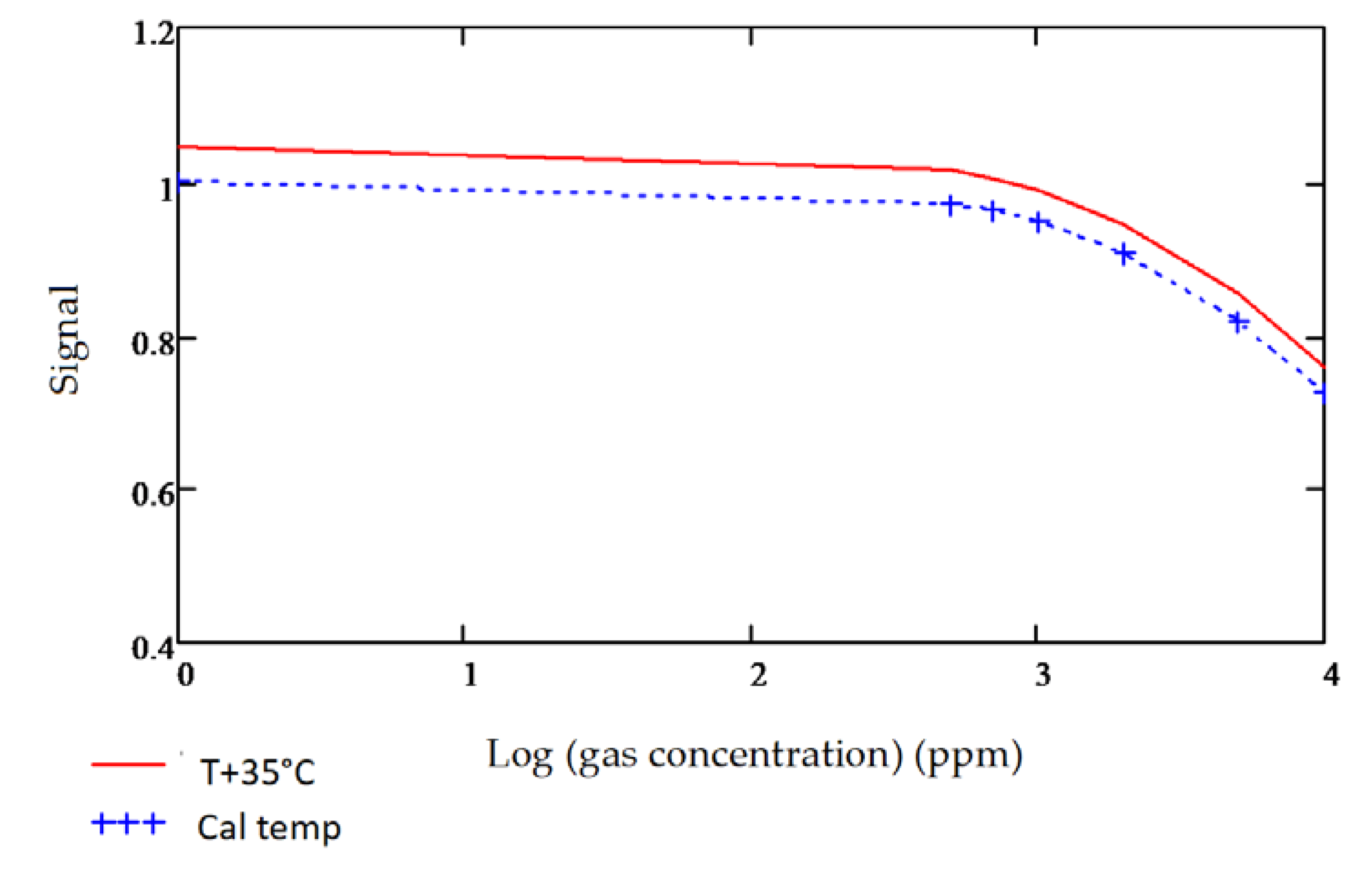
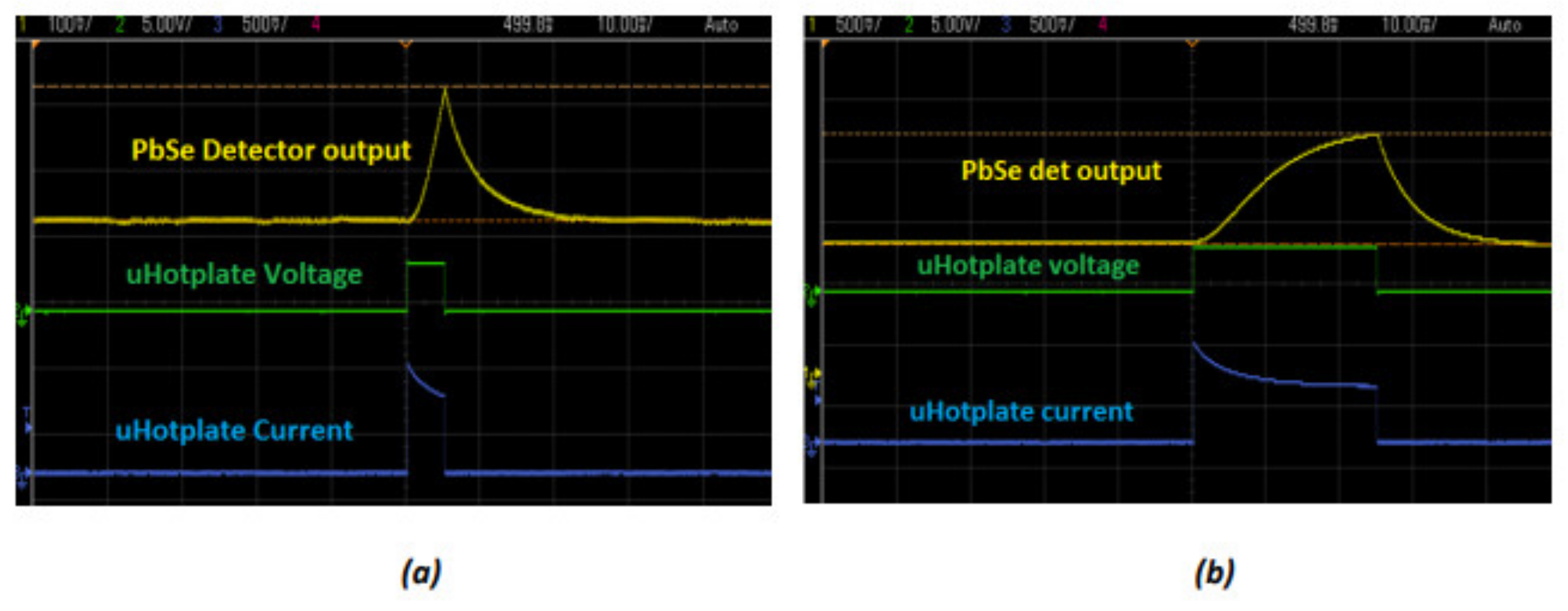
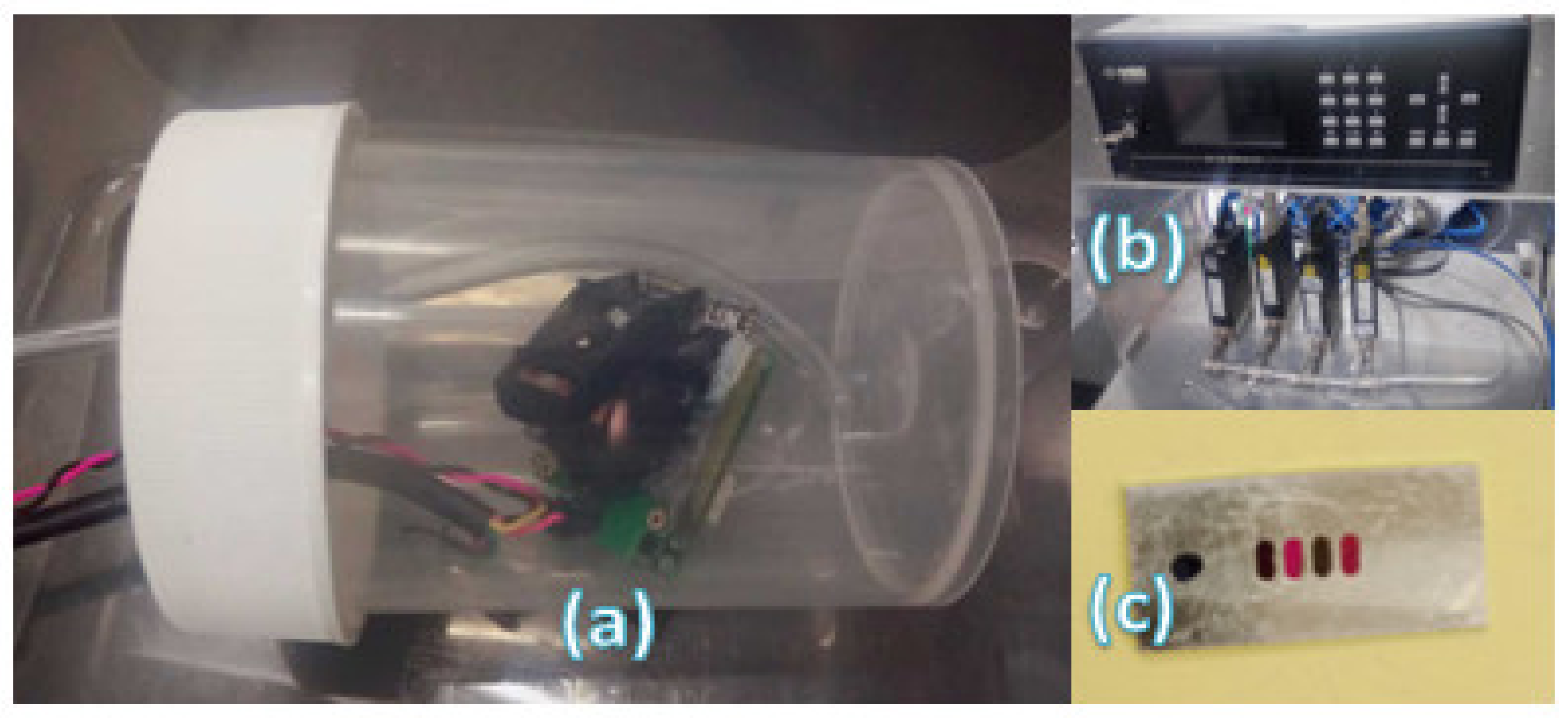


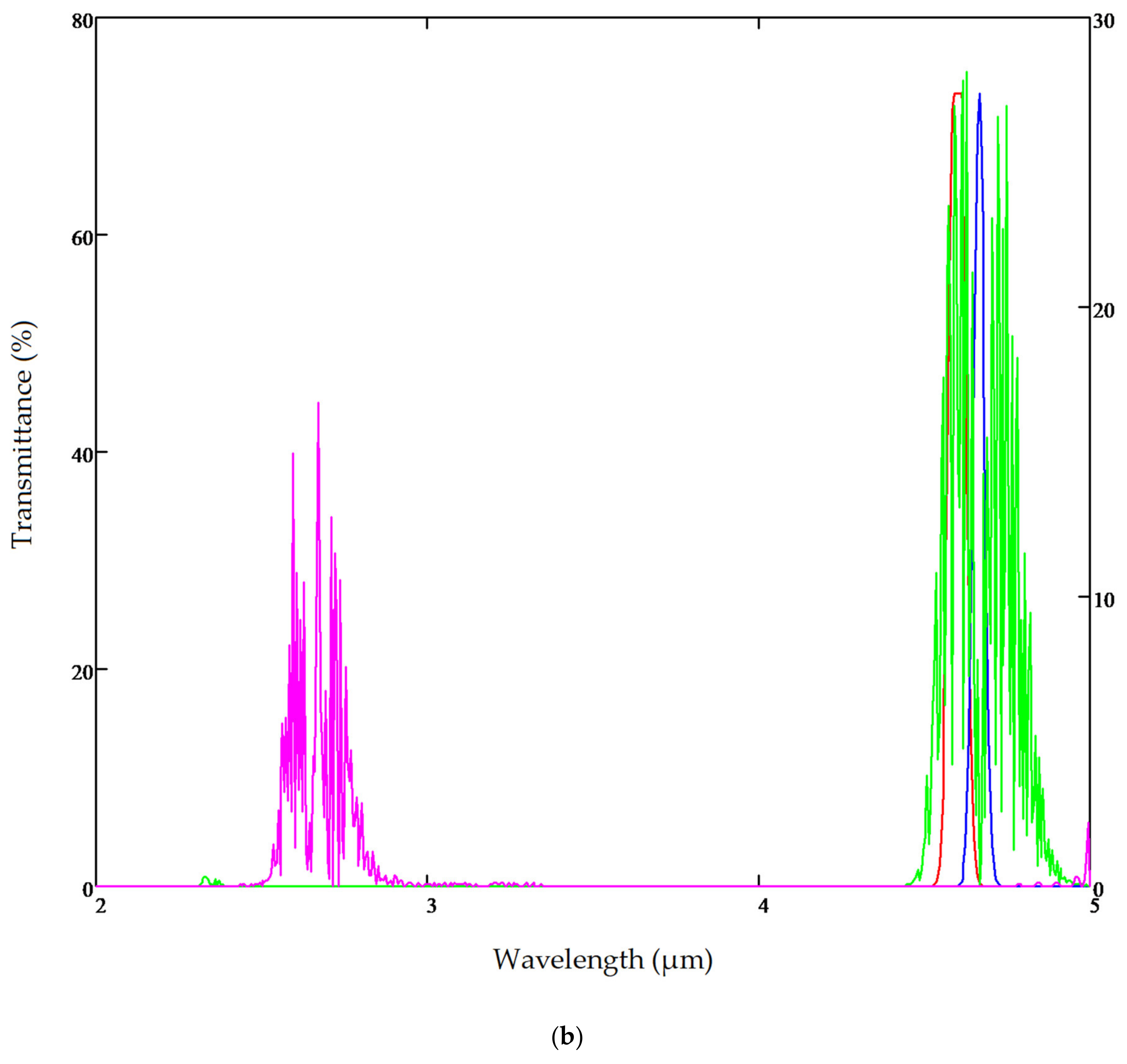

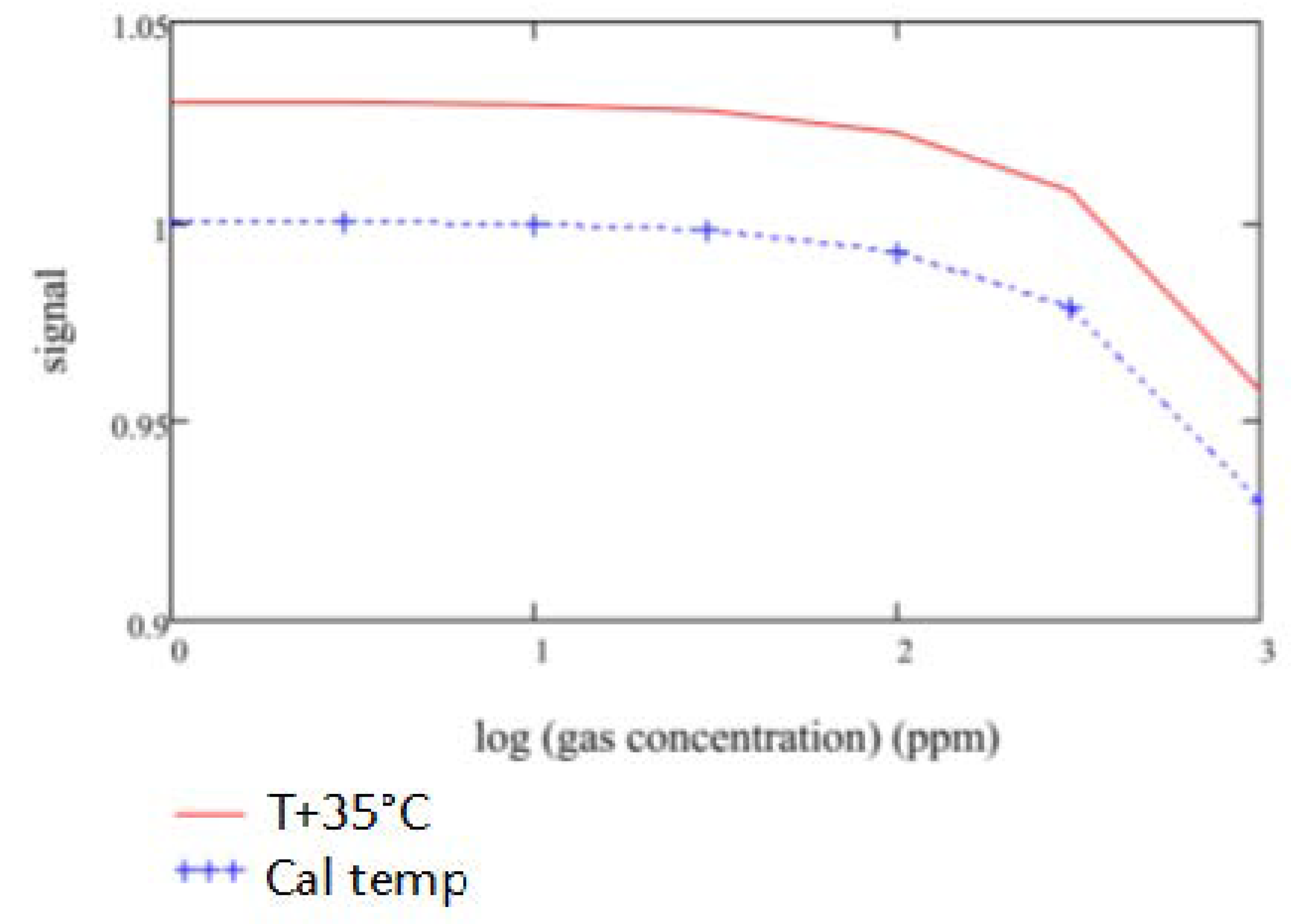
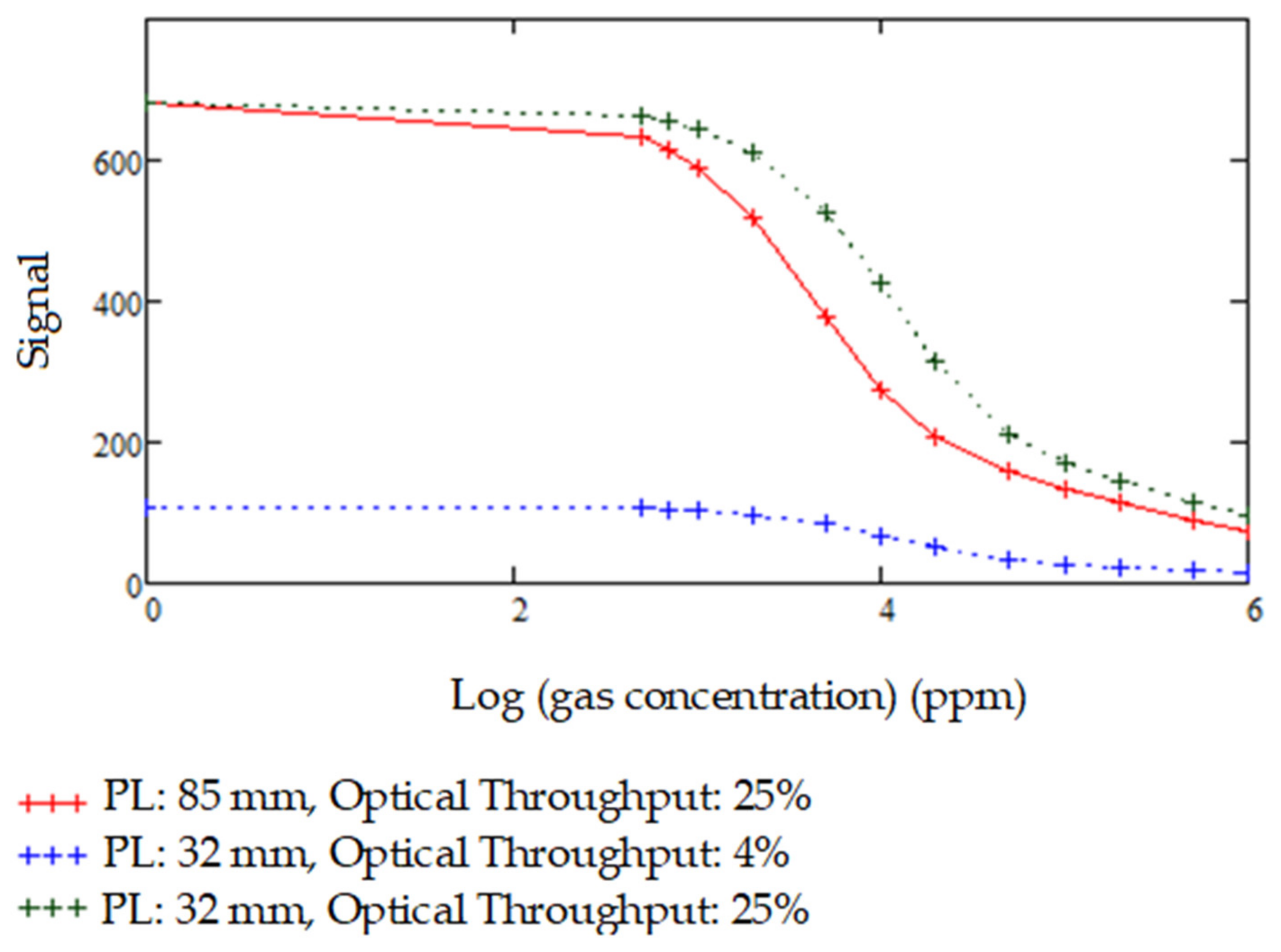
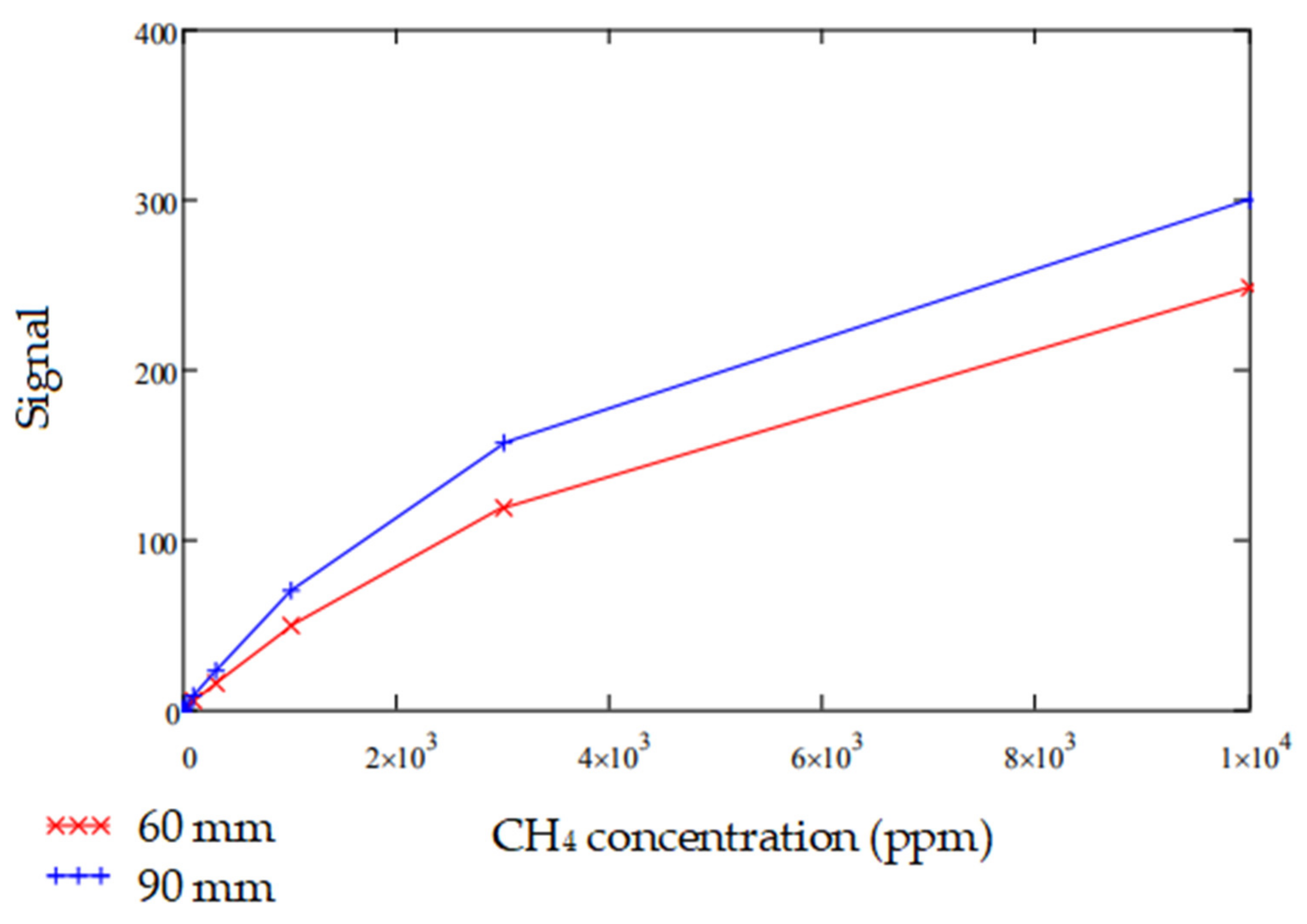
| Measurement Range | Accuracy of Measurement |
|---|---|
| 0 to 100 ppm | ±25 ppm of measured reading |
| 100 to 1000 ppm | ±1% of measured reading |
| 21,000 to 1,000,000 ppm | ±1.1% of measured reading |
| Gas | Samples Required | Pulses Required | Total Time (s) | Total Energy (mJ) | Average Power Consumption (mW) |
|---|---|---|---|---|---|
| CO2 | 100 | 1 | 1 | 13 | 13 |
| CH4 | 100 | 1 | 1 | 13 | 13 |
| CO | 100,000 | 1000 | 1000 | 13,000 | 13 |
| NO2 | 100,000 | 1000 | 1000 | 13,000 | 13 |
| H2S | 1,000,000 | 10,000 | 10,000 | 13,000 | 13 |
| NH3 | 1,000,000 | 10,000 | 10,000 | 13,000 | 13 |
| (a): CO | ||||
| Filter | Central-λ (um) | FWHM of Peak (um) | FWHM of Slope (um) | Transmission % |
| Signal | 4.6 | 1 | 0.5 | 73 |
| Reference | 4.665 | 0.5 | 0.5 | 73 |
| (b): NO2 | ||||
| Filter | Central-λ (um) | FWHM of Peak (um) | FWHM of Slope (um) | Transmission % |
| Signal | 3.43 | 1 | 0.5 | 73 |
| Reference | 3.495 | 0.5 | 0.5 | 73 |
| (c): NH3 | ||||
| Filter | Central-λ (um) | FWHM of Peak (µm) | FWHM of Slope (µm) | Transmission % |
| Signal | 3.0 | 1 | 0.5 | 73 |
| Reference | 3.065 | 0.5 | 0.5 | 73 |
| (d): H2S | ||||
| Filter | Central-λ (um) | FWHM of Peak (µm) | FWHM of Slope (µm) | Transmission % |
| Signal | 3.98 | 1 | 0.5 | 73 |
| Reference | 3.92 | 0.5 | 0.5 | 73 |
| (e): CH4 | ||||
| Filter | Central-λ (um) | FWHM of Peak (µm) | FWHM of Slope (µm) | Transmission % |
| Signal | 3.33 | 3.0 | 2 | 73 |
| Reference | 3.5 | 1.6 | 2 | 73 |
| (f): CO2 | ||||
| Filter | Central-λ (um) | FWHM of Peak (µm) | FWHM of Slope (µm) | Transmission % |
| Signal | 4.26 | 3.0 | 2 | 73 |
| Reference | 4.6 | 1.6 | 2 | 73 |
| Target Gas ppm Range | CO2 | CH4 | CO | NO2 | H2S | NH3 |
|---|---|---|---|---|---|---|
| 0 to 1000 | 25 ppm | 25 ppm | 8% | 9.9% | 11.9% | 12.6% |
| 1000 to 10,000 | 1% | 1% | 1.39% | 3.12% | 5.6% | 7.6% |
| 10,000 to 1,000,000 | 3% | 1.1% | 0.8% | 1% | 2.3% | 4.8% |
| Integration time (s) | 1 s | 1 s | 4 min | 4 min | 42 min | 43 min |
© 2020 by the authors. Licensee MDPI, Basel, Switzerland. This article is an open access article distributed under the terms and conditions of the Creative Commons Attribution (CC BY) license (http://creativecommons.org/licenses/by/4.0/).
Share and Cite
Muhiyudin, M.; Hutson, D.; Gibson, D.; Waddell, E.; Song, S.; Ahmadzadeh, S. Miniaturised Infrared Spectrophotometer for Low Power Consumption Multi-Gas Sensing. Sensors 2020, 20, 3843. https://doi.org/10.3390/s20143843
Muhiyudin M, Hutson D, Gibson D, Waddell E, Song S, Ahmadzadeh S. Miniaturised Infrared Spectrophotometer for Low Power Consumption Multi-Gas Sensing. Sensors. 2020; 20(14):3843. https://doi.org/10.3390/s20143843
Chicago/Turabian StyleMuhiyudin, Manu, David Hutson, Desmond Gibson, Ewan Waddell, Shigeng Song, and Sam Ahmadzadeh. 2020. "Miniaturised Infrared Spectrophotometer for Low Power Consumption Multi-Gas Sensing" Sensors 20, no. 14: 3843. https://doi.org/10.3390/s20143843
APA StyleMuhiyudin, M., Hutson, D., Gibson, D., Waddell, E., Song, S., & Ahmadzadeh, S. (2020). Miniaturised Infrared Spectrophotometer for Low Power Consumption Multi-Gas Sensing. Sensors, 20(14), 3843. https://doi.org/10.3390/s20143843





